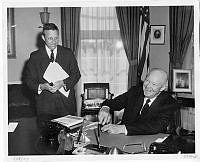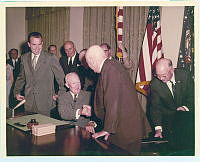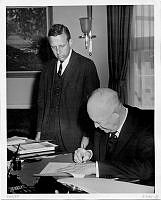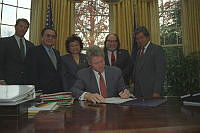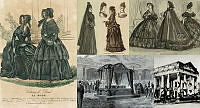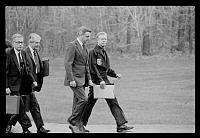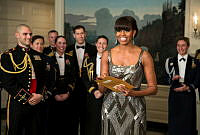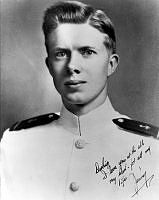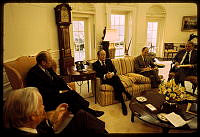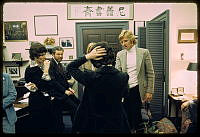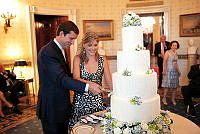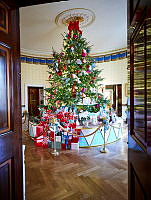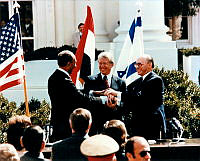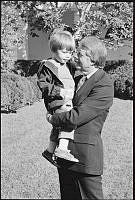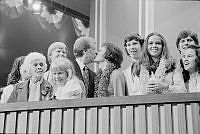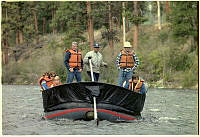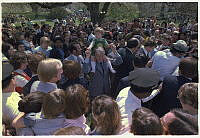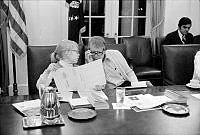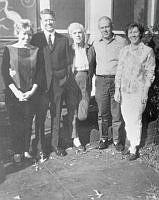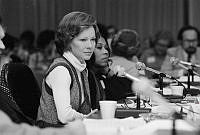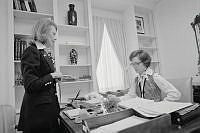Rubenstein Center Scholarship
Jimmy Carter and Sports
The presidency is a stressful job, but many presidents find ways to ease their anxieties. Some bring hobbies with them to the White House. For example, Franklin D. Roosevelt collected stamps, books, and model ships.1 Grover Cleveland enjoyed the peacefulness of fishing; Dwight Eisenhower took up painting; and Bill Clinton played the saxophone. In addition to pastimes, many presidents relieve stress by exercising or playing sports. Theodore Roosevelt loved horseback riding and hiking; Herbert Hoover had Hoover-Ball; Harry Truman took long walks; Richard Nixon bowled, and Gerald Ford swam!

President Jimmy Carter and White House Chief of Staff Hamilton Jordon walk off the White House Tennis Court on March 5, 1977.
Jimmy Carter Presidential Library & Museum/NARAPresident Jimmy Carter’s interests in sports have varied over time though he much preferred playing versus spectating. His father James Sr. (Earl), an enthusiastic tennis player, built a tennis court on the family farm in Plains, Georgia. When he got to Washington, President Carter played “tennis more than any other single thing” during his first two years in office.2 However, the sport became a source of controversy after former White House speechwriter Jim Fallows revealed that requests to use the court needed to be approved by the president. On April 30, 1979, President Carter faced a volley of questions about Fallows’ claim: “I have never personally monitored who used or did not use the White House tennis court,” though he admitted letting his secretary, Susan Clough, receive requests from White House staff “so that more than one person would not want to use the same tennis court simultaneously.”3

President Jimmy Carter jogs on the White House Grounds on November 20, 1978.
Jimmy Carter Presidential Library & Museum/NARACarter also enjoyed running, an interest that stretched back to his childhood in Plains. Carter often had to walk or run home after school, and during his time at the United States Naval Academy he ran on the cross-country team. During his presidency, he began jogging several miles almost every day. In an interview with Sports Illustrated, President Carter remarked, “the most beneficial sport to me is running. It’s not time-consuming. I can go out and run, for me, a fairly fast two miles in about 15 minutes, or run three miles in 25 minutes, or take a slower pace—10 minutes to a mile—and run seven miles. Then I can come back in and go back to work shortly.”4

Jimmy Carter meets with Henry “Hank” Aaron in the Oval Office on August 15, 1978.
Jimmy Carter Presidential Library and Museum/NARABeyond playing sports for exercise and amusement, President Carter made a concerted effort to connect with more Americans through sports. On August 15, 1978, President Carter met with retired baseball legend Hank Aaron at the White House to celebrate breaking Babe Ruth’s home run record. On April 8, 1974, Aaron drove a 0-1 pitch from Los Angeles Dodgers pitcher Al Downing over the left-center wall at Atlanta-Fulton County Stadium. Governor Carter was in attendance that night and witnessed Aaron’s historic achievement, and the two men developed a friendship that lasted for decades until Aaron’s passing in 2021. As president, Carter attended Game 7 of the 1979 World Series between the Baltimore Orioles and Pittsburgh Pirates—and later invited the Pirates to celebrate their championship at the White House. However, President Carter’s real passion was softball – he frequently organized competitive softball games with Secret Service agents, staff, friends, and family.5

On September 13, 1978, First Lady Rosalynn Carter hosted a reception for members of the National Association for Stock Car Racing (NASCAR) at the White House.
Jimmy Carter Presidential Library and Museum/NARAOne of President Carter’s favorite sports to watch was stock-car racing. “I used to go out to the Atlanta Speedway and ride in the pace car and be with the drivers during the preliminary review of the racing rules,” he said in an interview.6 Carter grew up around the sport and came to admire not only the racers and pit crews but also the strategy and techniques behind racing. The Carters invited more than 400 drivers, crew members, representatives, and their families to the White House for a NASCAR reception on September 13, 1978. The idea for the event began as a campaign promise, and while President Carter followed through, he was unable to join the fun. He was spinning his tires at Camp David, negotiating the Camp David Accords with Prime Minister Menachem Begin of Israel and President Anwar Sadat of Egypt. Back at the White House, picnic tables were spread across the South Lawn for a feast of baked ham, beef, and strawberry shortcake.7 First Lady Rosalynn Carter waved a green flag to start the event, and she later joined country music legend Willie Nelson on stage for a special performance.8

On June 9, 1978, President Jimmy Carter welcomed the championship-winning Washington Bullets basketball team at the White House.
Jimmy Carter Presidential Library and Museum/NARAWhile he was not the first president to welcome championship-winning teams to the White House, President Carter was the first to host celebrations for champions of the three major professional sport leagues at that time—the National Basketball Association (NBA), the National Football League (NFL), and Major League Baseball (MLB).9 In 1978, he welcomed the reigning NBA Champion Washington Bullets in an East Room ceremony. Carter demonstrated his dribbling skills, and later joked: “The last time Washington had a champion was when Franklin Roosevelt was President. And this is really a hope that I might have brought good luck to Washington.”10 The president asked, “Is the fat lady here? I wish I had thought of that during the 1976 campaign. There were a lot of times during 1976 when I thought the ball game might be over, at least other people did. But I knew the fat lady had to sing.”11 During the Eastern Conference Finals against Philadelphia, Bullets head coach Dick Motta famously quipped, "The opera isn't over till the fat lady sings." The team embraced this attitude, as did Bullets organization, creating merchandise, marketing materials, and even hiring a woman to portray an opera singer as a team mascot. The Washington Bullets gifted President Carter a t-shirt with the slogan, and he grinned while holding it up for all to see.12

Jimmy Carter hosts a reception in the East Room honoring athletes from the Pittsburgh Steelers and Pirates on February 22, 1980.
Jimmy Carter Presidential Library and Museum/NARAOn February 22, 1980, President Carter did something unprecedented—he hosted two championship-winning teams at the same time. Both the Pittsburgh Pirates and Pittsburgh Steelers were honored that day in the East Room, and Carter recognized the cooperation, unity, and brotherhood that both teams demonstrated during their remarkable playoff runs. Pittsburgh deserved “to be called the ‘City of Champions,’” the president noted to the room of more than 320 attendees. “What they have done has united a community, has united a region of our Nation, and has aroused the admiration of every American who's interested in sports, interested in courage, interested in achievement, interested in cooperation and teamwork, interested in the spirit of patriotism and the value of a close family relationship.”13 The Pirates gifted the president a hat, and the Steelers a “Terrible Towel.” Later that evening, the 1980 U.S. Olympic Men’s Hockey Team defeated the Soviet Union in Lake Placid, New York. Famously nicknamed the “Miracle on Ice,” President Carter phoned Team USA head coach Herb Brooks to congratulate him and his players on their hard-earned victory. The Carters later hosted the hockey team and other Olympic athletes at the White House, but the event drew criticism as the president had vowed to boycott the Summer Olympic games over the 1979 Soviet invasion of Afghanistan.14

President Barack Obama celebrates the 1985 Super Bowl Champion Chicago Bears at the White House on October 7, 2011. The team’s 1986 reception was canceled because of the Space Shuttle Challenger tragedy.
Official White House Photo by Pete SouzaToday, presidents continue this tradition by inviting many different championship-winning teams to the White House. While this is honor is generally reserved for the reigning champions, past champions can also be celebrated after the fact – for example, President Barack Obama celebrated the 1985 NFL Champion Chicago Bears and the 1972 NFL Champion Miami Dolphins, the only team in modern NFL history to complete a perfect season (17-0 record). As sports have become more and more popular in American society and culture, presidents have embraced hosting champions at the White House and expanded the tradition to include men and women’s teams, professional teams, and collegiate teams. These events not only allow presidents to recognize a major achievement by a group of athletes, but also demonstrate relatability as sports fans and associate themselves with winners.














